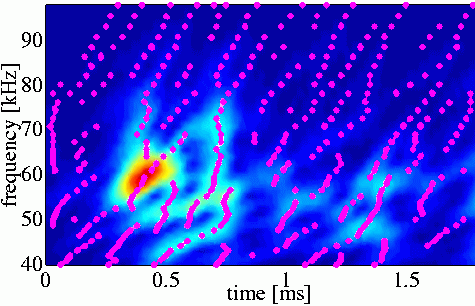Rolf Müller - rolf.mueller@yale.edu
Roman Kuc
Intelligent Sensors Laboratory,
EE Department, Yale University
New Haven, CT, 06520
Popular version of paper 2aAB9
Presented Tuesday morning, November 2, 1999
138th ASA Meeting, Columbus, Ohio
The work presented here seeks to advance biologically inspired sensing technology based on bat echolocation. Ultimately, we would like to design devices which mimic bats' superb sensing skills. Before we can do so, we need to take a close look at biology: Biological sensory systems are optimized in the process of evolution to perform a certain set of survival-relevant tasks. Finding the strengths of biological systems implies identifying those tasks and understanding the role played by the functional principles and constraints seen in nature.
Echolocating bats learn about their environments primarily through ultrasonic echoes. In realistic scenarios, e.g. a bat flying through a forest, several or even many reflecting structures will be illuminated by a single sonar pulse. An important sensory tasks bats face is to make sense of these echoes. To gain insight into the nature of the information contained in the echoes, we model reflecting structures to be composed of elementary reflectors.
 |
Even for a small number of such reflectors, like in the cluster of disks shown on the left, the received echoes are pronouncedly random in nature. The echo spectra, shown in the figure on the left for four different viewing positions, look noise-like and have little in common with each other. Bats flying through a structure-rich, natural environment will therefore experience the echoes in a similar manner as a human listening to a radio, which is most of the time tuned to frequencies away from the broadcasting channels. |
 | MethodEcho signals were obtained from foliages using a chirped ultrasonic pulse (a) similar to those produced by bats. A biomimetic time-frequency representation was generated from these echoes using a bank of bandpass filters (b) and a simple demodulation procedure consisting of rectification (c) and lowpass filtering (d). |
|
|
 | Modulation of sound envelopes has been found an important feature in the perception of speech and music. Comparing the ratio of signal power at two different modulation frequencies is a simple, yet useful feature for telling apart our two example trees. From the distributions of this ratio for the two trees studied (left) an error probability of 29% can be estimated. This is not particularly good, but provides a valuable starting point (see below). |
| In a chirp signal frequencies succeed each other in an orderly fashion. In our case frequency swept downward over time as a straight line. In the echo waveform many reflected chirps are superimposed. Peaks in the time-frequency plane (dots in the auditory spectrogram on the right) therefore tend to fall on straight lines indicating the position of a reflected chirp. The slope of the reflected chirps deviates from the original pulse however: Higher frequencies are delayed more than lower ones. The amount of this delay is again a telltale sign for the respective tree. |  |
 | Active bats usually emit an incessant train of ultrasonic pulses. Comparing the impression obtained from multiple echoes could therefore be used by the animals in order to corroborate their judgment about the type of an object. Starting from our moderate ability to tell the type of a foliage based on a single echo, we combined judgments from several echoes in order to achieve correct judgments 90% of the time (sequential estimation). The number of echoes needed to achieve this performance is shown on the left for the different signal features (m,r,pr,...) used. 5 to 10 echoes were sufficient for the desired performance level most of the time. These numbers are readily reconciled with bats' behavior. |
The notion of profoundly random echoes puts the biosonar of bats in an entirely new functional context, demanding sensory capabilities, which have not been previously investigated in these animals. We demonstrated in the present work that the analysis of a random sensory input is well commensurable with our current understanding of how the hearing system of bats functions. In order to make use of these insights for the design of sensing technology, particular attention has to be payed to the question, in which way biological signal representations may be parsimonious with respect to achieving sensing goals (e.g. classification) based on random inputs.